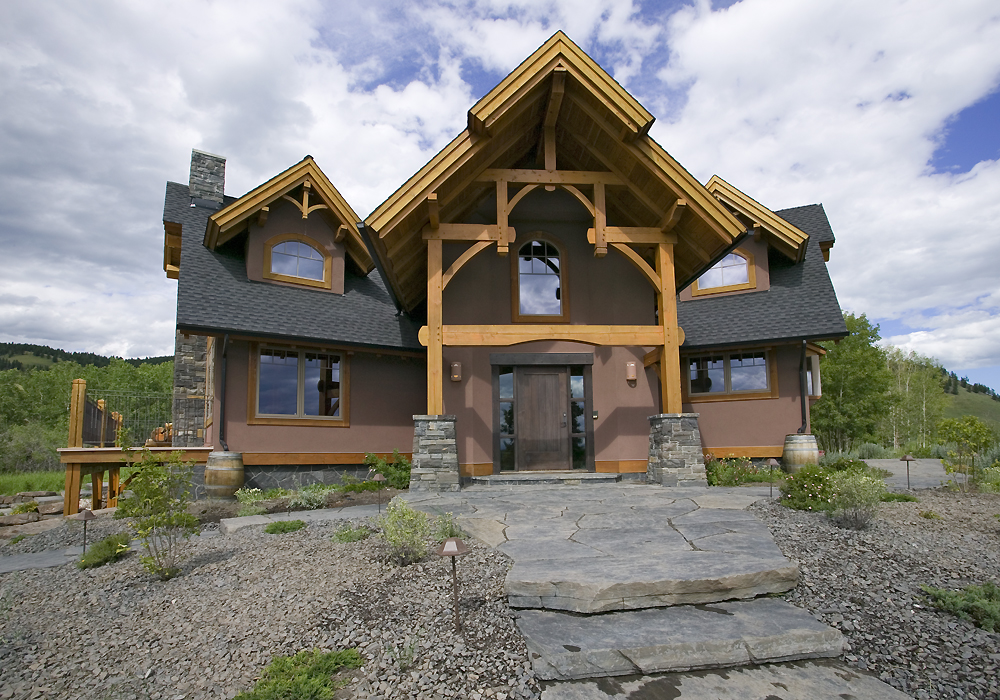
There’s no doubt about it — building your timber frame home can become very costly if you do not plan carefully. As with any construction project, unexpected expenses can climb if you’re not prepared. Thankfully, however, this doesn’t have to be the case. With proper planning, you can keep your timber frame cost managed, and your dream home can be built within your budget.
Here are some important factors to keep in mind.
Build Up, Not Out
You’ve likely heard this common adage, but it is easy to forget when planning to build a home. The reason this is key is not only because you won’t need as large of a lot, but because the roof and foundation are two of your highest cost variables. By building up- adding a floor level, or down- adding a basement, you can incorporate more floor space, without adding the cost of a larger roof area or foundation.
Find the Right Lot
Of course, cost matters when buying a lot, but don’t just buy the cheapest piece of land you can find. You need to consider what will need to be done to get your lot ready for building. How much vegetation will need to be cleared? Is the area equipped for your gas, plumbing, and electric needs? The more infrastructure that already exists, the less you’ll have to shell out to get your home up and running.
Use a Simple Floor Plan
If you’re looking to save money while still building a beautifully designed timber frame home, consider using a standard floor plan that your builder has used before. They will have already worked out all of the kinks, which means you will not only save on the design costs for your timber frame home, but also minimize excess material waste, saving money on multiple fronts.
Forgo The Spiral Staircase
…or any non-straight staircase, for that matter. A curved staircase may have a “wow” factor, but it also costs much more to build. The most economical staircases to build are straight, and placed on an interior or exterior wall.
Along those same lines, if you’re looking to stay within your budget, consider doing away with embellishments in general. The clean, straight lines created by your timber beams are very beautiful on their own, you don’t need as much ornamentation as you might think to create a stunning look.
Use Quality Materials
Using cheaper materials to keep your timber frame cost down might be tempting, but it can cost you in the long run. Choose a wood species that will age well, and not need to be replaced a few years after building. You don’t need to choose the most expensive timber out there, but going for the cheapest you can find will cause you heartache in the long run. Very few TF manufacturers use wood that won’t stand the test of time. Wood species used in TF will all stand the test of time if sheltered from the weather, which most of them are.
Consider a Hybrid Approach
Perhaps you don’t need exposed beams in the private rooms of your home, such as your bedrooms and bathrooms. You can decide whether there are areas of your home that don’t need the same aesthetic, and consider only a partial timber frame in those rooms, or potentially no timber frame at all. Using drywall for the ceilings and walls in less showy rooms can help keep the total bill down.
Keep Unnecessary Material Use to a Minimum
There are a number of ways to pare down the total amount of timber in your home. For instance, open floor plans are popular and can result in large, impressive rooms. Minimizing the number of walls in communal areas of your home can have a drastic impact on the total material needed.
Save Money Now on Things You Can Upgrade Later
Of course, if you can afford to install all of the appliances and fixtures now that you’ll want to use for years to come, that’s fantastic. But, if it comes to sacrificing on the “bones” of your home — its timber frame — just so you can afford your dream kitchen appliances, you might want to consider redirecting your funds. You can always go back and replace your sink or faucets; it’s much pricier to reimagine your frame after it’s been built.
Another thing you don’t want to leave for later is the groundwork for any future expansions. If you know you’ll want to finish your basement at a later date, for instance, make sure to get the electric and plumbing in place. If you’re hoping to expand the rooms in your home, have the foundation laid as such. It will cost much less to do that now than once the home has been built.
Aim for Energy Efficiency
Energy efficient appliances and alternative energy sources will likely cost more to set up now, but they will save you (and the planet) in the long run. Consider installing solar paneling to reduce your energy bill for years to come. Additionally, using recycled materials in your build can save money without compromising quality.
Building a home is, without a doubt, a costly endeavor, but with proper planning, you can keep your dream home within your budget. If you’re ready to start thinking about building your timber frame home, we would love to help make that dream a reality.
Blog Archive / Working with ITA (Industry Training Authority)